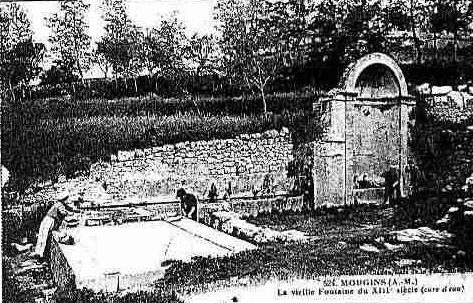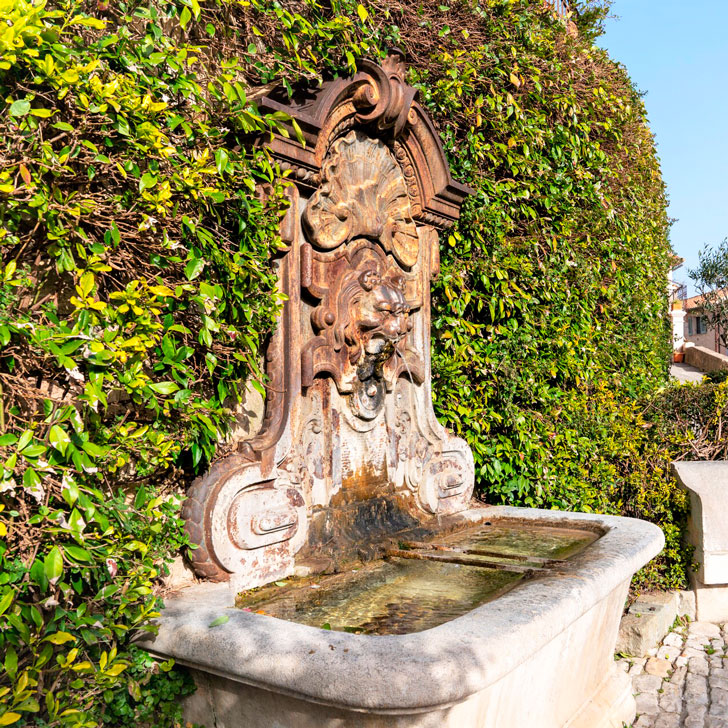Pools and fountains
Going back in time along the water…
A little history
For a long time, the inhabitants of Mougins, a village perched on a hill, had to make do with a rudimentary water supply, provided by two cisterns of varying size (the one in Place du Peyrou and the one in Place des Mûriers), a water tower (in Rue des Lombards) and a single well located in the heart of the old village, in Place du Commandant Lamy, close to the site of today’s fountain.
In the early years, water from the Horts de la Salle spring – just down the avenue du Moulin de la Croix – was pumped by a waterwheel and steam engine to fill the water tower in the rue des Lombards, which then distributed the water to every fountain in the village.
. In 1889, a certain Maître Giraud, a notary in Mougins, left a substantial sum of money in his will to the town of Mougins. Work was then undertaken to modernise the water supply. A fountain and a covered wash-house were built in the main squares, along with a water pipe to supply the school complex. The water reaches the village in a more stable way.
But it wasn’t until 1894 that the situation really improved. The creation of the Foulon canal brought water to Mougins from Plascassier and the Foulon spring, which supplied the tanneries in Grasse. This means that fountains and ponds can be fed directly and continuously with flowing water. This small revolution was celebrated on 30 September with a memorable party featuring entertainment, costumed dances and the sounds of music (brass bands, wind bands) and orphéons (choirs) from the various districts of Mougins, Mouans-Sartoux and the surrounding municipalities.
Not to be missed in the old village…
The Roger Vergé fountain
Le Lavoir – The Wash House
The Maryse Duhalde fountain
The Friendship Bench and the Carla Lavatelli fountain
The Commandant Lamy fountain
This sculptural fountain, which has forged the identity of the square in which it is located, represents Ceres, the goddess of agriculture, harvests and fertility in Roman mythology. At the time, it was known as the Vallat fountain, after the square where it stood.
It took on its current name in 1905, when a monument was unveiled in Mougins in memory of Commandant Lamy (grandson of the generous notary Maître Giraud, whose bequest had enabled the village fountains to be modernised, and a famous child of the village who went on to become a great explorer officer, particularly in Africa. The capital of Chad, N’Djamena, was initially named Fort Lamy in his honour).
To mark the occasion, the Vallat fountain was also moved a few metres and renamed, like the square, after Commandant Lamy. The well that used to supply it, i.e. before 1894, was removed during the works because there was no more water.
Also see…
- Les Isnardons fountain, Rue des Isnardons
- The Church fountain, Place de l’Église
- The two-headed fountain, Place Commandant Lamy
- The de Lattre de Tassigny fountain, Avenue du Maréchal de Lattre de Tassigny
- The Mûriers fountain,place des Mûriers
Firm favorite :
The old fountain
Situated at the bottom of the village, at the bend in a quiet, narrow street, this fountain-washhouse nestled in its bucolic setting evokes an impressionist painting. Of the nymphaeum type (a basin containing a spring considered sacred at the time), the complex probably dates from the 16th century. It consists of a so-called “miraculous” fountain, a mule trough, a washhouse, and a reservoir that distributed the water needed for watering the crops below the fountain thanks to a judicious system of small pipes, with a time slot for each field.











